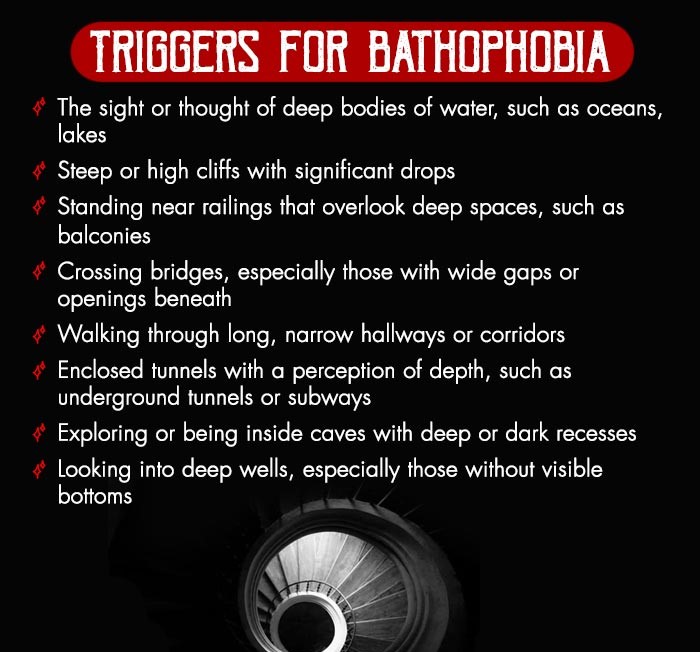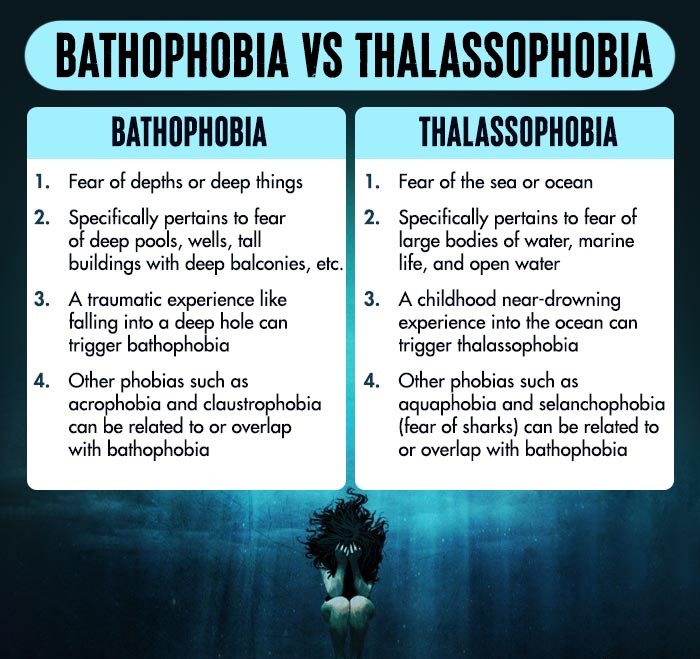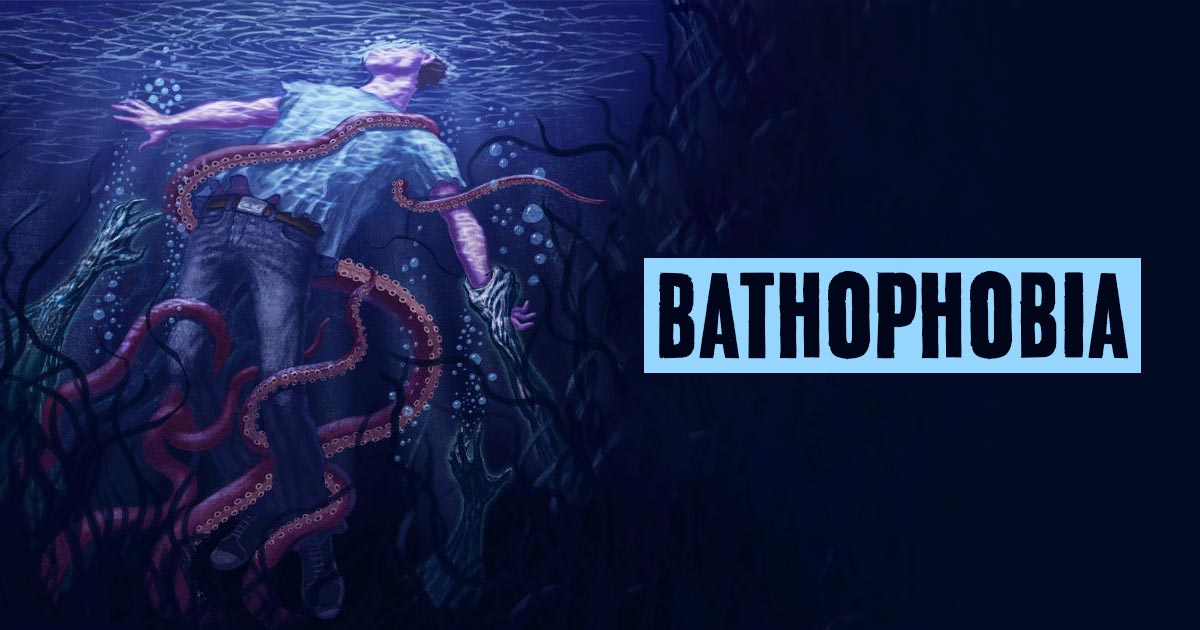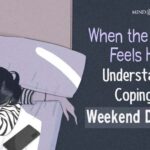Bathophobia is a specific phobia characterized by an intense and irrational fear of depths, such as deep water, holes, or caves. People with bathophobia may experience heightened anxiety, and frequent panic attacks, and resort to avoidance strategies, which can significantly disrupt their overall well-being and quality of life over an extended period of time.
What is Bathophobia?
Bathophobia meaning stems from the Greek words “bathos” (depth) and “phobos” (fear), which refers to an intense fear of deep or dark spaces, often triggering extreme anxiety or panic attacks. It can be triggered by 1 Cahill, K., Illustrator, A., Leighton, S., & Yeager, A. E. (2002). Harvard Medical School A Special Health Report from Harvard Medical School. Available from: http://hrccatalog.hrrh.on.ca/InmagicGenie/DocumentFolder/copinganxietyphobias.pdf various scenarios involving significant depths, such as deep bodies of water, holes, caves, or tall buildings with deep balconies.
Bathophobia affects around 10% of individuals 2 Specific Phobia. (n.d.). National Institute of Mental Health (NIMH). Available from: https://www.nimh.nih.gov/health/statistics/specific-phobia#:~:text=Prevalence%20of%20Specific%20Phobia%20Among%20Adults , causing extreme anxiety or fear specifically related to depths. Contributing factors may 3 Samra, C. K., & Abdijadid, S. (2023). Specific Phobia. In StatPearls. StatPearls Publishing. Available from: https://www.ncbi.nlm.nih.gov/books/NBK499923/#:~:text=Patients%20with%20a%20specific%20phobia,speaking%20about%20the%20feared%20stimulus. include traumatic experiences, a history of anxiety disorders or specific phobias, as well as genetic and environmental influences.
While the exact causes and risk factors are not fully understood, bathophobia shares similarities in symptoms with other types of specific phobias and can be diagnosed and treated using similar intervention methods.

Symptoms of Bathophobia
Here are some common 4 Muris, P., Schmidt, H., & Merckelbach, H. (1999). The structure of specific phobia symptoms among children and adolescents. Behaviour research and therapy, 37(9), 863–868. https://doi.org/10.1016/s0005-7967(98)00201-0 bathophobia symptoms that can be seen in an individual are:
- Bathophobia triggers extreme fear when confronted with deep or dark spaces
- A feeling of panic or terror when thinking about or encountering situations involving depth or darkness
- Avoiding situations that may trigger the phobia, such as deep water, caves, or holes
- Physical symptoms such as sweating, trembling, rapid heartbeat, or shortness of breath when facing the feared situation
- Difficulty functioning in daily life
- Awareness that the fear is excessive or unreasonable, but unable to control it
- Irrational thoughts or beliefs about the dangers of deep or dark spaces
- Sleep disturbances or nightmares related to the phobia

Bathophobia and Associated Mental Health Condition
The fear and anxiety associated with bathophobia can lead to various psychological 5 Steimer T. (2002). The biology of fear- and anxiety-related behaviors. Dialogues in clinical neuroscience, 4(3), 231–249. https://doi.org/10.31887/DCNS.2002.4.3/tsteimer effects, such as:
1. Anxiety Disorders
Bathophobia can contribute to or coexist with 6 Ströhle, A., Gensichen, J., & Domschke, K. (2018). The Diagnosis and Treatment of Anxiety Disorders. Deutsches Arzteblatt international, 155(37), 611–620. https://doi.org/10.3238/arztebl.2018.0611 other anxiety disorders, such as generalized anxiety disorder (GAD), panic disorder, or social anxiety disorder. The fear of depths may exacerbate overall anxiety levels and increase the risk of experiencing panic attacks or avoidance behaviors.
Read More About Anxiety Here
2. Depression
Prolonged fear and avoidance of situations related to bathophobia can lead to feelings of isolation, limitation, and low mood, potentially contributing to the development of 7 Goodwin G. M. (2015). The overlap between anxiety, depression, and obsessive-compulsive disorder. Dialogues in clinical neuroscience, 17(3), 249–260. https://doi.org/10.31887/DCNS.2015.17.3/ggoodwin depression.
Read More About Depression Here
3. Social and Occupational Impairment
Bathophobia triggers an individual’s daily life 8 Tsuchiya, M., Kawakami, N., Ono, Y., Nakane, Y., Nakamura, Y., Tachimori, H., Iwata, N., Uda, H., Nakane, H., Watanabe, M., Naganuma, Y., Furukawa, T. A., Hata, Y., Kobayashi, M., Miyake, Y., Takeshima, T., Kikkawa, T., & Kessler, R. C. (2009). Lifetime comorbidities between phobic disorders and major depression in Japan: results from the World Mental Health Japan 2002-2004 Survey. Depression and anxiety, 26(10), 949–955. https://doi.org/10.1002/da.20508 , making it difficult to engage in activities involving water or environments near deep bodies of water. This fear may limit social interactions, hinder participation in water-related recreational activities, or impact occupational choices and opportunities.
Causes of Bathophobia
The exact causes 9 Eaton, W. W., Bienvenu, O. J., & Miloyan, B. (2018). Specific phobias. The lancet. Psychiatry, 5(8), 678–686. https://doi.org/10.1016/S2215-0366(18)30169-X of bathophobia symptoms are not fully understood, but it is believed to be a combination of environmental, genetic, and psychological factors. Here are some possible causes of bathophobia:
- A traumatic experience, such as nearly drowning, falling into a deep hole, or being trapped in a cave, can trigger a fear response and develop into a phobia.
- Bathophobia can be learned by observing others’ fear or hearing about a frightening experience involving depths or darkness.
- Some studies suggest that phobias may have a genetic component, and individuals with a family history of anxiety disorders may be more prone to developing bathophobia.
- Imbalances in brain chemicals, such as serotonin and dopamine, may contribute to the development of fear of depths.
- Intense and traumatic portrayals of media exposure, such as showing shipwrecks, highlighting the darkness of a well can trigger the development of such phobias.
How to Diagnose Bathophobia
DSM-5 does not specifically include bathophobia diagnosis, the fear of depths. However, it can still be diagnosed using 10 Stewart J. E. (1994). Diagnosis and treatment of phobia. Professional nurse (London, England), 9(8), 549–552. traditional approaches, such as:
1. Initial Assessment
During the first appointment, the mental health professional will conduct an initial assessment, such as the symptoms, fears, and any other related concerns of an individual suffering from bathophobia.
2. Psychological Assessments
To gather more information 11 Meyer, G. J., Finn, S. E., Eyde, L. D., Kay, G. G., Moreland, K. L., Dies, R. R., Eisman, E. J., Kubiszyn, T. W., & Reed, G. M. (2001). Psychological testing and psychological assessment. A review of evidence and issues. The American psychologist, 56(2), 128–165. about this phobia, the mental health professional may use psychological assessment tools such as self-report questionnaires, fear hierarchy exercises, or anxiety scales like Hamilton anxiety scale 12 Porter, E., Chambless, D. L., McCarthy, K. S., DeRubeis, R. J., Sharpless, B. A., Barrett, M. S., Milrod, B., Hollon, S. D., & Barber, J. P. (2017). Psychometric Properties of the Reconstructed Hamilton Depression and Anxiety Scales. The Journal of nervous and mental disease, 205(8), 656–664. https://doi.org/10.1097/NMD.0000000000000666 .
3. Discussion
After gathering all the necessary information, the mental health professional would discuss their findings with the diagnosed individual. They would provide a diagnosis if applicable and explain the symptoms to the person. They may also discuss bathophobia treatment options and recommendations tailored to specific situations.
Treatment for Bathophobia
The treatment for this condition typically involves 13 Choy, Y., Fyer, A. J., & Lipsitz, J. D. (2007). Treatment of specific phobia in adults. Clinical psychology review, 27(3), 266–286. https://doi.org/10.1016/j.cpr.2006.10.002 a combination of therapy and, in some cases, medication, including:
1. Cognitive-Behavioral Therapy (CBT)
CBT helps individuals identify 14 Chand, S. P., Kuckel, D. P., & Huecker, M. R. (2022, September 9). Cognitive Behavior Therapy (CBT). National Library of Medicine; StatPearls Publishing. Available from: https://www.ncbi.nlm.nih.gov/books/NBK470241/ and challenge their fearful thoughts and beliefs about depths. It aims to restructure negative thought patterns and replace them with more realistic and positive thinking.
Read More About CBT Here
2. Exposure Therapy
This technique involves gradual and controlled 15 Sars, D., & van Minnen, A. (2015). On the use of exposure therapy in the treatment of anxiety disorders: a survey among cognitive behavioural therapists in the Netherlands. BMC psychology, 3(1), 26. https://doi.org/10.1186/s40359-015-0083-2 exposure to the fear of the depths. Under the guidance of a therapist, individuals are exposed to progressively challenging situations related to their fear, allowing them to develop coping mechanisms and reduce anxiety over time.
3. Virtual Reality Therapy
Using virtual reality 16 Maples-Keller, J. L., Bunnell, B. E., Kim, S. J., & Rothbaum, B. O. (2017). The Use of Virtual Reality Technology in the Treatment of Anxiety and Other Psychiatric Disorders. Harvard review of psychiatry, 25(3), 103–113. https://doi.org/10.1097/HRP.0000000000000138 technology as a bathophobia treatment that simulates environments related to depths in a safe and controlled setting. This therapy allows for gradual exposure and desensitization to fear.
4. Supportive Counseling
Engaging in individual or group counseling provides a safe space to discuss fears, gain support, and learn from others who have faced similar challenges.
5. Medication
In some cases, medications 17 Tariq, R. A., Vashisht, R., Sinha, A., & Scherbak, Y. (2023). Medication Dispensing Errors and Prevention. In StatPearls. StatPearls Publishing. Available from: https://www.ncbi.nlm.nih.gov/books/NBK519065/ such as anti-anxiety or antidepressant medications may be prescribed to help manage symptoms of anxiety or depression that accompany bathophobia. This is typically done in conjunction with therapy.
How to Overcome Bathophobia?
Here are some strategies that may assist 18 Davey, G. C., Burgess, I., & Rashes, R. (1995). Coping strategies and phobias: the relationship between fears, phobias and methods of coping with stressors. The British journal of clinical psychology, 34(3), 423–434. https://doi.org/10.1111/j.2044-8260.1995.tb01477.x you to overcome bathophobia:
- Researching the bathophobia meaning, its causes, common triggers, and symptoms can help to understand and psychoeducate individuals about their fear and provide a sense of control.
- Start by exposing to mild forms of water, such as shallow pools and gradually working way towards deeper water or larger bodies of water at a pace that feels comfortable.
- Practice deep breathing exercises or other relaxation techniques such as progressive muscle relaxation or mindfulness meditation.
- Reach out to supportive family members, friends, or support groups who can understand and empathize the condition.
- Consider seeking professional help from a therapist or counselor specializing in anxiety disorders or phobias.
Takeaway
Bathophobia, the fear of depths or drowning, is that it is a specific phobia that can cause significant distress and anxiety for individuals. While its exact prevalence is not well-documented, seeking professional help from a mental health specialist is important for proper diagnosis, understanding, and effective treatment. With appropriate strategies and support, individuals can learn to cope with and overcome bathophobia which leads to an improved quality of life.
At A Glance
- Bathophobia is the fear of depths or drowning.
- Symptoms include intense fear or anxiety around deep bodies of water, panic-like physical symptoms, and avoidance of water-related activities.
- Causes can include traumatic experiences, learned behavior, and genetic/environmental factors.
- Diagnosis involves discussions with a mental health professional to explore fears, triggers, and associated symptoms.
- Treatment options include cognitive-behavioral therapy (CBT), gradual exposure therapy, and medication for managing anxiety or panic symptoms.
- Coping strategies for bathophobia include psychoeducating oneself, gradual exposure to water, relaxation techniques, seeking support, and consulting a therapist.
Frequently Asked Questions (FAQs)
1. Is Bathophobia rare?
Bathophobia, the fear of depths or drowning, is relatively uncommon compared to more prevalent phobias such as arachnophobia (fear of spiders) or acrophobia (fear of heights). However, it is important to note that phobias can vary in prevalence among individuals and populations.
2. How many people suffer from Bathophobia?
According to the National Institute of Mental Health, phobias are the most prevalent mental health disorder in the United States. Approximately 10% of individuals with phobias experience intense anxiety or fear related to specific things, such as depth.
3. How to get rid of Bathophobia?
To get rid of bathophobia, i.e. the fear of depths, it typically involves a combination of therapeutic techniques and gradual exposure. Seeking professional help from a therapist specializing in anxiety disorders or phobias, can guide an individual through cognitive-behavioral therapy (CBT) and desensitization exercises to reduce symptoms of anxiety and overcome fear.
4. Can Bathophobia go away on its own?
In some cases, bathophobia may naturally diminish or go away on its own over time, especially if the fear is mild or has not significantly created an impact on an individual’s daily life. However, for persistent or severe cases, it is unlikely to resolve without intervention. Seeking professional help from a therapist or counselor become the primary important in such extreme cases.















